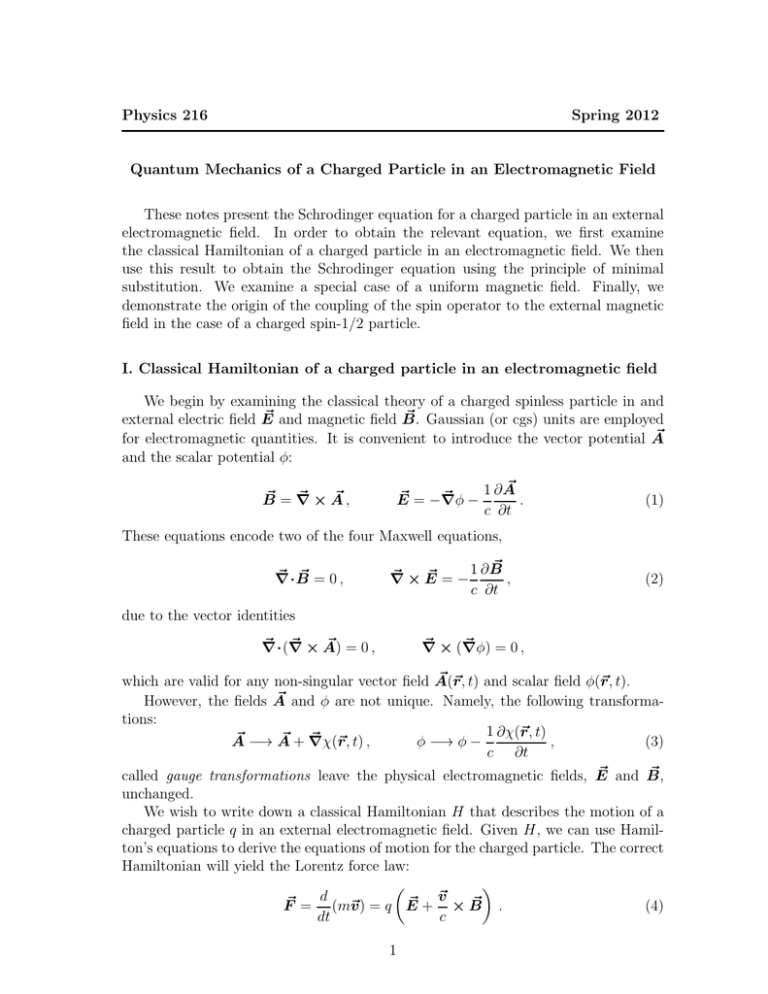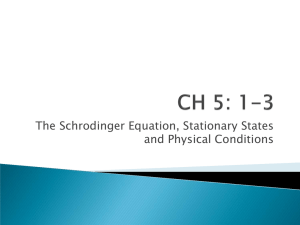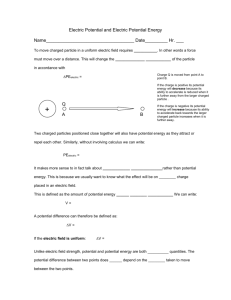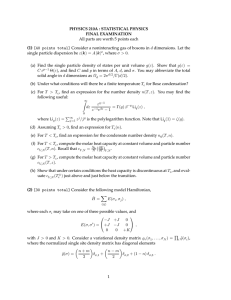Physics 216 Spring 2012 Quantum Mechanics of a Charged Particle
advertisement

Physics 216 Spring 2012 Quantum Mechanics of a Charged Particle in an Electromagnetic Field These notes present the Schrodinger equation for a charged particle in an external electromagnetic field. In order to obtain the relevant equation, we first examine the classical Hamiltonian of a charged particle in an electromagnetic field. We then use this result to obtain the Schrodinger equation using the principle of minimal substitution. We examine a special case of a uniform magnetic field. Finally, we demonstrate the origin of the coupling of the spin operator to the external magnetic field in the case of a charged spin-1/2 particle. I. Classical Hamiltonian of a charged particle in an electromagnetic field We begin by examining the classical theory of a charged spinless particle in and ~ and magnetic field B. ~ Gaussian (or cgs) units are employed external electric field E ~ for electromagnetic quantities. It is convenient to introduce the vector potential A and the scalar potential φ: ~ =∇ ~ ×A ~, B ~ ~ = −∇φ ~ − 1 ∂A . E c ∂t (1) These equations encode two of the four Maxwell equations, ~ B ~ = 0, ∇· ~ ~ ×E ~ = − 1 ∂B , ∇ c ∂t (2) due to the vector identities ~ ∇ ~ × A) ~ = 0, ∇·( ~ × (∇φ) ~ ∇ = 0, ~ r , t) and scalar field φ(~ which are valid for any non-singular vector field A(~ r , t). ~ However, the fields A and φ are not unique. Namely, the following transformations: 1 ∂χ(~ r , t) ~ −→ A ~ + ∇χ(~ ~ r , t) , A φ −→ φ − , (3) c ∂t ~ and B, ~ called gauge transformations leave the physical electromagnetic fields, E unchanged. We wish to write down a classical Hamiltonian H that describes the motion of a charged particle q in an external electromagnetic field. Given H, we can use Hamilton’s equations to derive the equations of motion for the charged particle. The correct Hamiltonian will yield the Lorentz force law: ~ v d ~ ~ ~ v) = q E + × B . (4) F = (m~ dt c 1 The Hamiltonian for a charged particle in an electromagnetic field is given by: 1 H= 2m ~ qA p ~− c ! · ~ qA p ~− c ! + qφ . (5) We shall verify this result by using Hamilton’s equations to compute the equations of motion and demonstrate that these coincide with eq. (4). For a Hamiltonian of the form H = H(pi , xi ), Hamilton’s equations are given by: ∂H dxi = , ∂pi dt − ∂H dpi = , ∂xi dt where i runs over the three directions of space. In particular, the partial derivative with respect to pi is computed at fixed xi and the partial derivative with respect to xi is computed at fixed pi . Inserting eq. (5) into Hamilton’s equations yields: dxi pi q = − Ai , dt m mc ! ~ ~ qA ∂A dpi q ∂φ p ~− · Fi ≡ = −q . dt mc c ∂xi ∂xi vi ≡ (6) (7) Eq. (6) is equivalent to: q~ . p ~ = m~ v+ A c The quantity m~ v is called the mechanical momentum, which is not equal to p ~, which is called the canonical momentum. The reason for this nomenclature will be addressed later. If we now substitute the equation for p ~ in eq. (7), we obtain: ~ d q q ∂A ∂φ mvi + Ai = ~ v· −q . dt c c ∂xi ∂xi (8) As noted above, the partial derivative with respect to xi is computed while holding pi (or equivalently holding vi ) fixed. Hence, ~ v· ~ ∂ ∂A ~ . = (~ v · A) ∂xi ∂xi Thus, we can rewrite eq. (8) as: d dAi ∂φ q ∂ ~ (~ v · A) − −q , (mvi ) = dt c ∂xi dt ∂xi or equivalently in vector form as, " # ~ d A q ~ d ~ − ~ . ∇(~ v · A) − q ∇φ (m~ v) = dt c dt 2 (9) ~ ~ By the To make further progress, note that dA/dt is a full time-derivative of A. chain rule, 3 ~ X ~ dxi ~ ∂A ∂A dA = + . dt ∂t ∂x dt i i=1 ~ has two The chain rule reflects the physical fact that the full time-derivative of A ~ r , t), and (ii) implicit time-dependence by sources: (i) explicit time-dependence of A(~ virtue of the fact that the charged particle moves on a trajectory ~ r=~ r (t). Noting that vi ≡ dxi /dt [where ~ r ≡ (x1 , x2 , x3 )], we can rewrite the chain rule above as: ~ dA ∂A ~ A ~. = + (~ v · ∇) dt ∂t Inserting this result in eq. (9) yields: " # ~ ∂ A q ~ d ~ − (~ ~ A ~− ~ . ∇(~ v · A) v · ∇) − q ∇φ (m~ v) = dt c ∂t (10) Finally, we make use of the vector identity: ~ × A) ~ = ∇(~ ~ v · A) ~ − (~ ~ A ~. ~ v × (∇ v · ∇) This should remind you of the famous BAC-CAB rule for computing the triple cross~ × (B ~ × C) ~ = B( ~ A· ~ C) ~ − C( ~ A· ~ B). ~ In the case of the identity above, product: A you have to be a little careful since one of the vectors is a differential operator. So, ~ × (B ~ × C) ~ = B( ~ A· ~ C) ~ − (A· ~ B) ~ C. ~ The easiest way to the more correct version is A prove the identity above is to write both sides in component form and simplify the left hand side until it takes the form of the right hand side. I leave this as an exercise for the reader. Applying the above identity to eq. (10) yields: ! ~ d 1 q ∂ A ~ + ~ × A) ~ − q ∇φ . (m~ v) = ~ v × (∇ dt c c ∂t Finally, using eq. (1), we end up with d ~+q~ ~, (m~ v) = qE v×B dt c which coincides with eq. (4), as required. So far, we have described the motion of a charged particle in an external electromagnetic field. If the particle also feels an external potential V (~ r , t) that is unrelated to the external electromagnetic field, then we should use the more general Hamiltonian, ! ! ~ ~ 1 qA qA H= p ~− · p ~− + qφ + V (~ r , t) . (11) 2m c c 3 Eq. (11) suggests the principle of minimal substitution, which states that the Hamiltonian for a charged particle (of charge q) in an external electromagnetic field can be obtained from the corresponding Hamiltonian for an uncharged particle by making the following substitutions: q~ r , t) , p ~ −→ p ~ − A(~ c V (~ r , t) −→ V (~ r , t) + qφ(~ r, t) . II. Schrodinger equation for a charged particle in an external electromagnetic field We first write down the time-dependent Schrodinger equation, H |ψ(t)i = i~ where 1 H= 2m ~ qA p ~− c ! · ∂ |ψ(t)i , ∂t ~ qA p ~− c ! + qφ + V (~ r , t) . For simplicity, we will set the external potential V (~ r, t) to zero, and assume that the electromagnetic potentials are time-independent. Then, the time-independent Schrodinger equation for stationary state solutions |ψi is given by: ! ~ 2 qA 1 p ~− |ψi = (E − qφ) |ψi . 2m c Comparing this with the time-independent Schrodinger equation for a free particle, one can introduce the principle of minimal substitution at this point by noting that the time-independent Schrodinger equation for a charged particle of charge q is obtained by the substitution: a~ p ~ −→ p ~ − A(~ r , t) , c E −→ E − qφ(~ r, t) . In the coordinate representation, we identify p ~ with the differential operator ~ Hence, the time-independent Schrodinger equation is given by: −i~∇. q ~ i2 1 h ~ i~∇ + A(~ r) ψ(~ r) + qφ(~ r )ψ(~ r) = Eψ(~ r) . 2m c In obtaining the above result, we implicitly assumed that we should identify the canonical momentum p ~ [and not the mechanical momentum m~ v ] with the operator ~ The momentum operator p −i~∇. ~ is called the canonical momentum because it satisfies the canonical commutation relations, [xi , pj ] = i~δij . 4 This is one of the essential postulates of quantum mechanics. Had we tried to identify ~ we would have found that the resulting theory does not reduce to m~ v with −i~∇, the classical limit as ~ → 0. The Schrodinger equation written above can be expanded out: q2 ~ 2 iq~ ~ ~ iq~ ~ ~ −~2 ~ 2 ψ(∇· A) + A ψ + qφψ = Eψ , ∇ ψ+ A· ∇ψ + 2m mc 2mc 2mc2 where we have suppressed the coordinate arguments of the electromagnetic vector and scalar potentials and the wave function ψ. At this point, the equation can be ~ and φ, I can perform a simplified by choosing a gauge. I claim that given any A ~ and φ satisfy: gauge transformation [cf. eq. (3)] such that the resulting A ~ A ~ = 0, ∇· φ = 0, Coulomb gauge conditions ~ , φ) are the initial vector and scalar potential. Making a gauge transforSuppose (A mation, r , t) 1 ∂χ(~ ~′ = A ~ + ∇χ(~ ~ r , t) , . A φ′ = φ − c ∂t To ensure that the Coulomb gauge conditions are satisfied, we require that: ~ 2 χ(~ ~ A(~ ~ r , t) , ∇ r , t) = −∇· ∂χ(~ r , t) = cφ(~ r , t) . ∂t One can always find a χ(~ r , t) such that the above conditions are satisfied! By choosing ~ A ~ ′ = φ′ = 0 as desired. Thus, the Schrodinger such a χ(~ r , t), it then follows that ∇· equation in the Coulomb gauge is given by: −~2 ~ 2 iq~ ~ ~ q2 ~ 2 ∇ ψ+ A· ∇ψ + A ψ + qφψ = Eψ . 2m mc 2mc2 III. Schrodinger equation for a charged particle in a uniform electromagnetic field We can use the results obtained Section II to examine two cases. 1. A uniform electric field In this case, it is not convenient to use the Coulomb gauge. Instead, we choose ~ = −∇φ. ~ ~ A = 0 and E The Schrodinger equation becomes: −~2 ~ 2 ∇ ψ + qφψ = Eψ , 2m which has the same form as the usual Schrodinger equation for a particle in a potential. 5 2. A uniform magnetic field ~ is uniform in space and In this case, we will choose the Coulomb gauge. If B time-independent, then, one may choose: ~, ~ = −1~ r×B A 2 φ = 0. ~ and B. ~ Since A ~ is timeTo check that this is correct, we use eq. (1) to compute E ~ = 0. Next, we compute B ~ = ∇ ~ × A. ~ independent and φ = 0, it follows that E Noting that: Ax = − 12 (yBz − zBy ) , Ay = − 12 (zBx − xBz ) , Az = − 21 (xBy − yBx ) , one easily evaluates: ~ ×A ~ = x̂ ∇ ∂Az ∂Ay − ∂y ∂z + ŷ ∂Ax ∂Az − ∂z ∂x + ẑ ∂Ay ∂Ax − ∂x ∂y ~. = x̂Bx + ŷBy + ẑBz = B Furthermore, note that ~ A ~ = − 1 ∇·(~ ~ r × B) ~ = 0, ∇· 2 which confirms that we have indeed chosen the Coulomb gauge. Thus, the timeindependent Schrodinger equation reads: 2 iq~ −~2 ~ 2 ~ ∇ψ ~ + q (~ ~ 2 ψ = Eψ . (~ r × B)· r × B) ∇ ψ− 2m 2mc 8mc2 This equation can be simplified by noting the vector identity: ~ ∇ψ ~ = −B ~ ·(~ ~ . (~ r × B)· r × ∇ψ) Hence, iq~ q ~ ~ ∇ψ ~ =− ~· ~ ~ − (~ r × B)· B r × ∇ψ . 2mc 2mc i We identify the canonical angular momentum operator, ~~ ~ ≡~ . L r× ∇ i (12) This is to be distinguished from the mechanical angular momentum ~ r × (m~ v ). You can check that the canonical angular momentum operators of eq. (12) satisfy the usual angular momentum commutation relations, [Li , Lj ] = i~ 3 X ǫijk Lk . k=1 Hence, we can write: − iq~ ~ ∇ψ ~ =− q B ~ · Lψ ~ . (~ r × B)· 2mc 2mc 6 Finally, if we use the vector identity, ~ 2 = r2 B ~ 2 − (~ ~ 2, (~ r × B) r · B) then the time-independent Schrodinger equation for a charged particle of charge q in ~ is given by: an external uniform magnetic field B i −~2 ~ 2 q ~ ~ q2 h 2 ~ 2 ~ 2 ψ = Eψ . (13) ∇ ψ− B ·L ψ + r B − (~ r · B) 2m 2mc 8mc2 IV. Schrodinger equation for a charged spin-1/2 particle in an electromagnetic field So far, we have neglected spin. For a spin-1/2 particle, the wave function is a spinor of the form ψ1 ψ= . ψ2 Likewise, the Hamiltonian operator must be a 2 × 2 matrix. To determine the correct Hamiltonian for a charged spin-1/2 particle in an electromagnetic field, we choose the Hamiltonian for a free uncharged spin-1/2 particle to be: (~ σ ·~ p )2 . (14) H= 2m Noting that (~ σ ·~ p )2 = p ~ 2 I, where I is the 2 × 2 identity matrix, we recover the expected free particle Hamiltonian. In order to obtain the Hamiltonian for a charged spin-1/2 particle, we apply the principle of minimal substitution to eq. (14).1 Thus, we choose ! ! ~ ~ 1 qA qA H= σ· p ~ ~− + qφI . ~ σ· p ~− 2m c c We can simplify the first term above by writing: ! ! X ~ ~ qA qA qAi qAj ~ σ· p ~− σ· p ~ ~− = σi σj pi − pj − c c c c ij = X ijk = qAi qAj (δij I + iǫijk σk ) pi − pj − c c ~ qA p ~− c !2 I− iq X ǫijk (pi Aj + Ai pj )σk , c ijk (15) 1 If one applies the principle of minimal substitution to H = (~ p 2 /(2m))I, one obtains a spinindependent Hamiltonian, which is in conflict with experiment. Remarkably, applying the principle of minimal substitution to eq. (14) yields a spin-dependent Hamiltonian, which is in very good agreement with experiment. 7 where we have used the sigma matrix identity, σi σj = I δij + i 3 X ǫijk σk . k=1 Note that X ǫijk pi pj = ij X ǫijk Ai Aj = 0 , ij since ǫijk = −ǫjik is a totally antisymmetric tensor. To evaluate the second term in eq. (15) above, we use X X ǫijk (pi Aj + Ai pj )σk = ǫijk (pi Aj − Aj pi )σk , ijk ijk where we have used the antisymmetry of ǫijk followed by an appropriate relabeling of indices. Employing the operator identity (which is most easily checked in the coordinate representation), pi Aj − Aj pi = [pi , Aj ] = −i~ ∂Aj , ∂xi it follows that X X X ∂Aj = −i~Bk , ǫijk (pi Aj + Ai pj ) = ǫijk [pi , Aj ] = −i~ ǫijk ∂x i ij ij ij ~ =∇ ~ ×A ~ implies that: after recognizing that B Bk = X ǫijk ij ∂Aj . ∂xi Consequently, ~ σ· ~ qA p ~− c ! σ· ~ ~ qA p ~− c ! = ~ qA p ~− c !2 I− ~q ~ σ ·B . ~ c Thus, the Hamiltonian for a charged spin-1/2 particle in an external electromagnetic field is: ! ~ 2 qA ~q 1 ~ + qφ I . p ~− I− ~ σ ·B H= 2m c 2mc That is, if H0 is the spin-independent part of the Hamiltonian, then H = H0 − q ~ ~ S ·B , mc ~ = 1 ~~ σ. where we have identified the spin-1/2 operator, S 2 8 (16) Let us apply the above results to obtain the time-independent Schrodinger equation for a charged spin-1/2 particle in a uniform magnetic field. Using eqs. (13) and (16), it follows that: i 2 h −~2 ~ 2 q ~ ~ 2 ~2 ~ 2 ψ = Eψ . ~ ψ+ q r B − (~ r · B) ∇ ψ− B ·(L + 2S) 2m 2mc 8mc2 ~ + 2S ~ above. This means that we have Note especially the relative factor of 2 in L predicted that an elementary charged spin-1/2 particle has a g-factor equal to 2. In ~ S ~ in the above equation with L+g ~ ~ more general circumstances, we will replace L+2 S, where g is determined from experiment. 9






